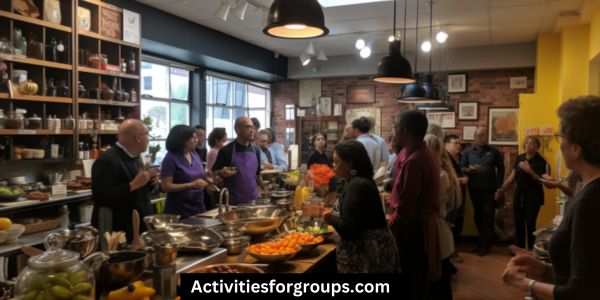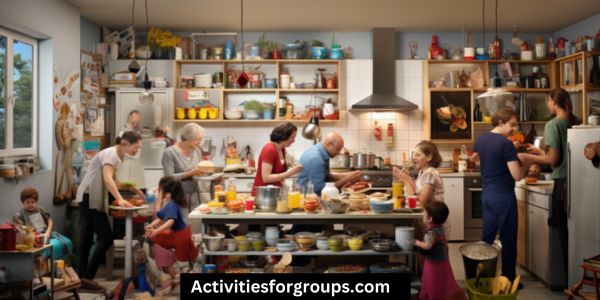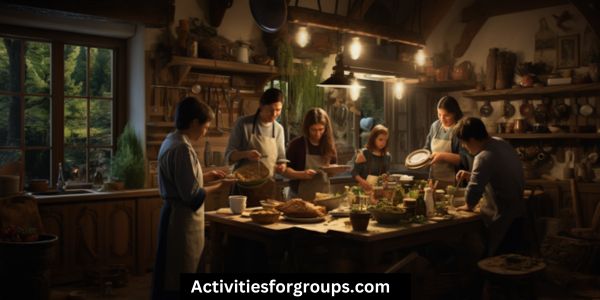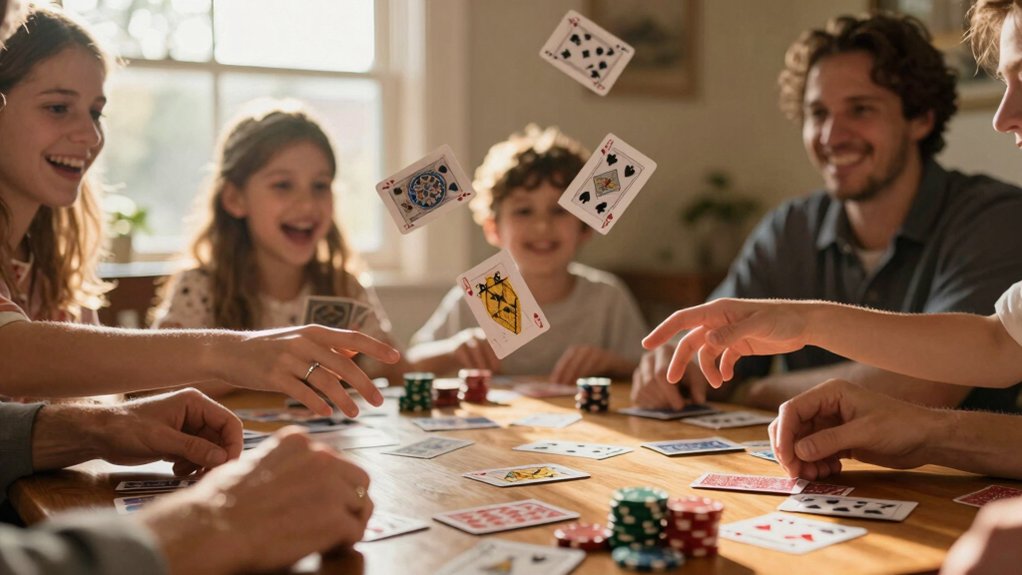Are you ready to host a group cooking class? If so, you’ll need to have the right equipment on hand to make it a success.
From pots and pans to kitchen tools, ingredients, utensils, and supplies, this article will help you make sure you have everything you need.

Let’s get started so you can start cooking with your group!
Pots and Pans
You’ll need a good selection of pots and pans to organize a successful group cooking class. Pots come in a variety of sizes to accommodate different recipes and cooking styles. A large stock pot is great for boiling large quantities of pasta, while a small saucepan is better for simmering sauces. Pans come in a variety of materials, such as copper, stainless steel, and aluminum. Be sure to consider safety precautions when selecting which pots and pans to use, as certain materials can become hot enough to cause burns.
When selecting pots and pans for a group cooking class, make sure they’re non-stick. This will help minimize food sticking to the pan and creating a mess, as well as ensure food hygiene. It will also make it easier to clean-up afterwards, which is especially important when you have multiple people in the kitchen. Make sure to include a variety of sizes and materials for the different dishes that you’ll be preparing.
To ensure the safety of your group, be sure to provide clear instructions on how to handle the pots and pans. This includes instructions on how to safely move them, how to use them correctly, and how to store them after each use. Be sure to also provide the necessary protective equipment, such as heat-resistant gloves, to ensure the safety of your guests.
Having the right pots and pans for a group cooking class is key to ensuring a successful experience. Make sure to select a range of sizes and materials that will accommodate a variety of recipes, and be sure to provide safety precautions and food hygiene guidelines for a safe and successful experience.
Kitchen Tools
In addition to pots and pans, you’ll also need to equip your kitchen with the right kitchen tools for a successful group cooking class.
This means having items such as measuring cups and spoons, whisks, spatulas, tongs, a cutting board, knives, a vegetable peeler, and a food thermometer. These tools are essential for ensuring food safety, following recipes accurately, and selecting the right ingredients.
Additionally, you should consider having a blender, food processor, and other small-appliance items to help you prepare meals more quickly and efficiently. Finally, for serving dishes, you’ll need serving utensils, such as serving spoons and forks, as well as serving platters and bowls.
With all of these kitchen tools, you’ll be able to organize a successful and enjoyable group cooking class.
Ingredients

Building on the necessary kitchen tools, you’ll also need to stock up on the ingredients needed for your group cooking class. Whether you’re teaching basic cooking techniques or more complex dishes, it’s important to make sure you have the ingredients on hand.
Here are some items you’ll need:
- High-quality, fresh ingredients – Depending on the dishes you’re serving, you’ll need to have the freshest ingredients possible. Consider getting organic produce and premium cuts of meats if your menu is especially ambitious.
- Variety of spices and herbs – You’ll need a wide range of spices and herbs to truly bring out the flavor of the dishes you’re preparing. Make sure to stock up on the most commonly used seasonings.
- Serving dishes – You’ll need to have enough dishes to accommodate your guests. Consider getting the same style of plates and bowls to create a cohesive presentation.
These are the basic ingredients needed for a successful group cooking class. Make sure to plan ahead and buy everything you need before your class starts. With the right kitchen tools and the right ingredients, you’ll be able to teach your guests a variety of cooking techniques and delicious dishes.
Utensils
Aside from ingredients, you’ll also need to have the right utensils to effectively run a cooking class. This includes items to prepare and serve the food, as well as any special cooking tools.
Serving platters, bowls, and plates will be necessary to serve the food. You’ll also need a variety of pots and pans to cook the food, as well as knives, spatulas, and other kitchen tools.
For preparing ingredients, you’ll need a cutting board, a grater, a blender, and a food processor. Additionally, you’ll need a variety of measuring cups and spoons, as well as bowls and strainers.
Supplies

Aside from the necessary utensils, you’ll also need to have the right supplies for your cooking class. Serving dishes, such as plates, bowls, and platters, are essential to serve the food that you have prepared. You’ll also need to ensure that you have food safety supplies, such as hand sanitizer and disposable gloves, to ensure that the food is handled safely and hygienically. Finally, you’ll need to have a variety of condiments, such as salt, pepper, and oil, to complete the dishes you have prepared.
In terms of serving dishes, you should have a mix of different sizes and materials for your cooking class. Depending on the type of food you’re preparing, you should have ceramic dishes, glass dishes, and plastic dishes. You’ll also need to ensure that you have enough dishes to serve all the guests attending your class.
In terms of food safety, you should make sure that you have hand sanitizer and disposable gloves readily available. This will ensure that all the food is handled safely and hygienically. You should also make sure to have a separate area for food preparation and serving the food. This will help minimize the risk of contamination.
Finally, you should always have a variety of condiments on hand for your cooking class. Salt, pepper, and oil are essential ingredients in most dishes, so make sure you have enough for all the guests attending your class. You can also add more condiments, such as soy sauce, vinegar, and chili sauce, to give the dishes more flavor.
Frequently Asked Questions
How Many People Should I Plan to Accommodate in the Class?
When planning a group cooking class, consider how many people it will accommodate. Make sure to follow cooking tips and food hygiene practices to ensure safety.
What Type of Recipes Should I Prepare?
When selecting recipes, consider ingredients you can easily source and that will appeal to the group. Think of flavors, cooking techniques, and dietary restrictions when making your choices.
What Safety Measures Should I Take During the Class?
When organizing a cooking class, ensure food safety and class etiquette. Wear protective clothing, wash hands, and keep food surfaces clean. Monitor food temperatures and store food safely. Educate participants on safe cooking practices.
What Kind of Budget Should I Plan for the Cooking Class?
When budgeting for your cooking class, consider menu planning and budgeting strategies. Plan ahead and estimate costs for ingredients, supplies, and any other costs you may incur.
Do I Need to Provide Any Additional Materials for the Class?
Yes, you’ll need to provide a cooking space and a selection of recipes. Make sure you have all the necessary equipment to make the class a success.
Conclusion
You’re all set to organize a group cooking class!
With the necessary equipment, kitchen tools, ingredients, utensils, and supplies, you’re ready to get your group cooking.
Plus, you’ll be able to enjoy the food you make together.
So, grab your friends, roll up your sleeves, and get cooking!




Leave a Reply